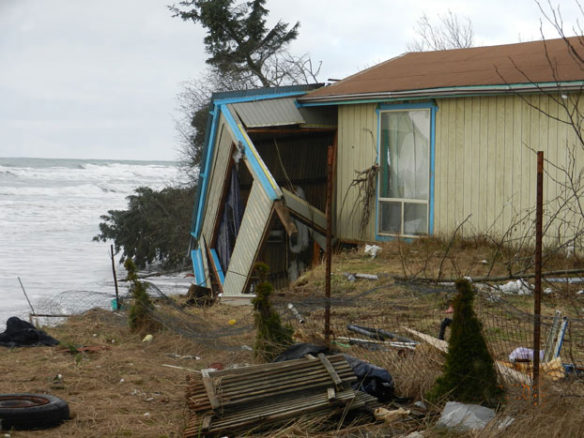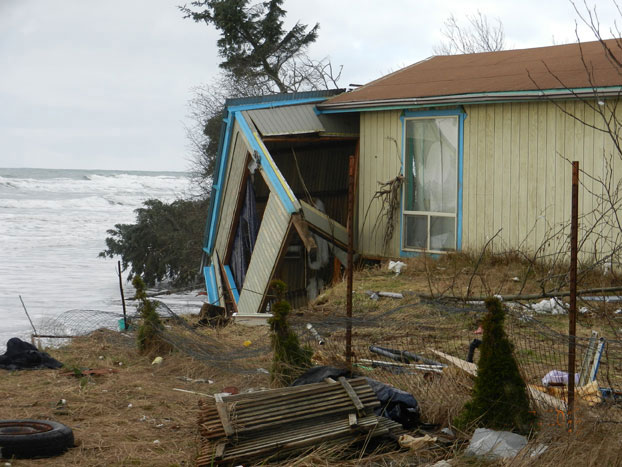
Severe coastal erosion in the Pacific Northwest, Washington state. Photograph courtesy of: ©Norma Longo.
“Cape Shoalwater, Washington is the fastest eroding stretch of land on the west coast, maybe even the entire Western Hemisphere.” —Eddie Jarvis.
Excerpts;
There’s a reason a quiet and desolate strip of sand here is nicknamed Washaway Beach. Coastal erosion has claimed an average of 100 feet of this shoreline every year for the last century, according to Washington’s Department of Ecology.
That makes North Cove the fastest-eroding place on the West Coast…
Read Full Article; NBC News (11-24-2018)
Washaway Beach, Cape Shoalwater; By Eddie Jarvis; (10-01-2013)
Despite its relative anonymity, Cape Shoalwater, Washington is the fastest eroding stretch of land on the west coast, maybe even the entire Western Hemisphere…
“Seawalls Kill Beaches,” Open Letters by Warner Chabot And Rob Young, (10-03-2014)
A softer approach, living shorelines as an alternative to a hardened coast; PortCity (05-12-2018)
Research over the last decade points toward the pursuit of living shorelines for coastal landowners seeking erosion control.But, with regulatory lag and miles of shoreline lost each year to harsh structures, it’s not always easy…
“Living Shorelines” Will Get Fast Track to Combat Sea Level Rise; Scientific American (07-06-2016)
As sea levels rise along U.S. coasts, it may soon get easier for people and local governments to obtain federal permits to build what are known as “living shorelines,” natural or nature-based structures designed to protect communities and infrastructure from extreme storms and flooding even as they protect habitat.
“A Never-Ending Commitment”: The High Cost of Preserving Vulnerable Beaches; ProPublica (09-27-2018)
Beach rebuilding efforts won’t stave off climate change impacts forever; Guardian UK (09-20-2018)
Coastal property was once king. Fears of climate change are undermining its value; The WSJ (10-31-2018)
In a growing number of coastal communities, homes near the sea are appreciating more slowly than those inland. That’s bad news for people on the beach, good news for those farther away…
Coastal residents need to set aside money now to cope with future flooding; Sun Sentinel (07-10-2018)
Sea-level rise is a national economic insecurity. According to the National Ocean Service, 39 percent of the U.S. population in 2010 lived in counties that are on shorelines…
Sea level rise is already eroding home values, unbeknownst to their owners; NOLA (08-21-2018)
Sea Level Rise Will Reshape U.S. Population In All 50 States; Yale E360 (04-19-2017)
Sea level rise could cause mass migrations that will affect not just the United States’ East Coast, but reshape communities deep in the heart of the country, according to new research…
Surrendering to rising seas; Scientific American (08-2018)
Coastal communities struggling to adapt to climate change are beginning to do what was once unthinkable: retreat…
Let’s end war with ocean, Op-Ed by Orrin H. Pilkey (04-2017)
The immediate future most certainly holds more miles of sandbags, resulting in more narrowed and ugly beaches.But this trend can be halted and reversed. Now is the time to make peace with the ocean.The time is now to stop sandbagging, both physically with no more shore-hardening structures, and politically with no more exceptions to the intent of the rules, no more undermining existing legislation, and a return to enforcement…
The only answer to rising seas is to retreat; By Orrin H. Pilkey & Keith C. Pilkey; The News & Observer (10-18-2017)
Except for the timing, there is no controversy among scientists regarding sea level rise. Defending the coast and holding the shoreline in place ultimately will be futile. With a three-foot or a six-foot sea level rise, we will retreat, probably beginning within the next 50 years…









